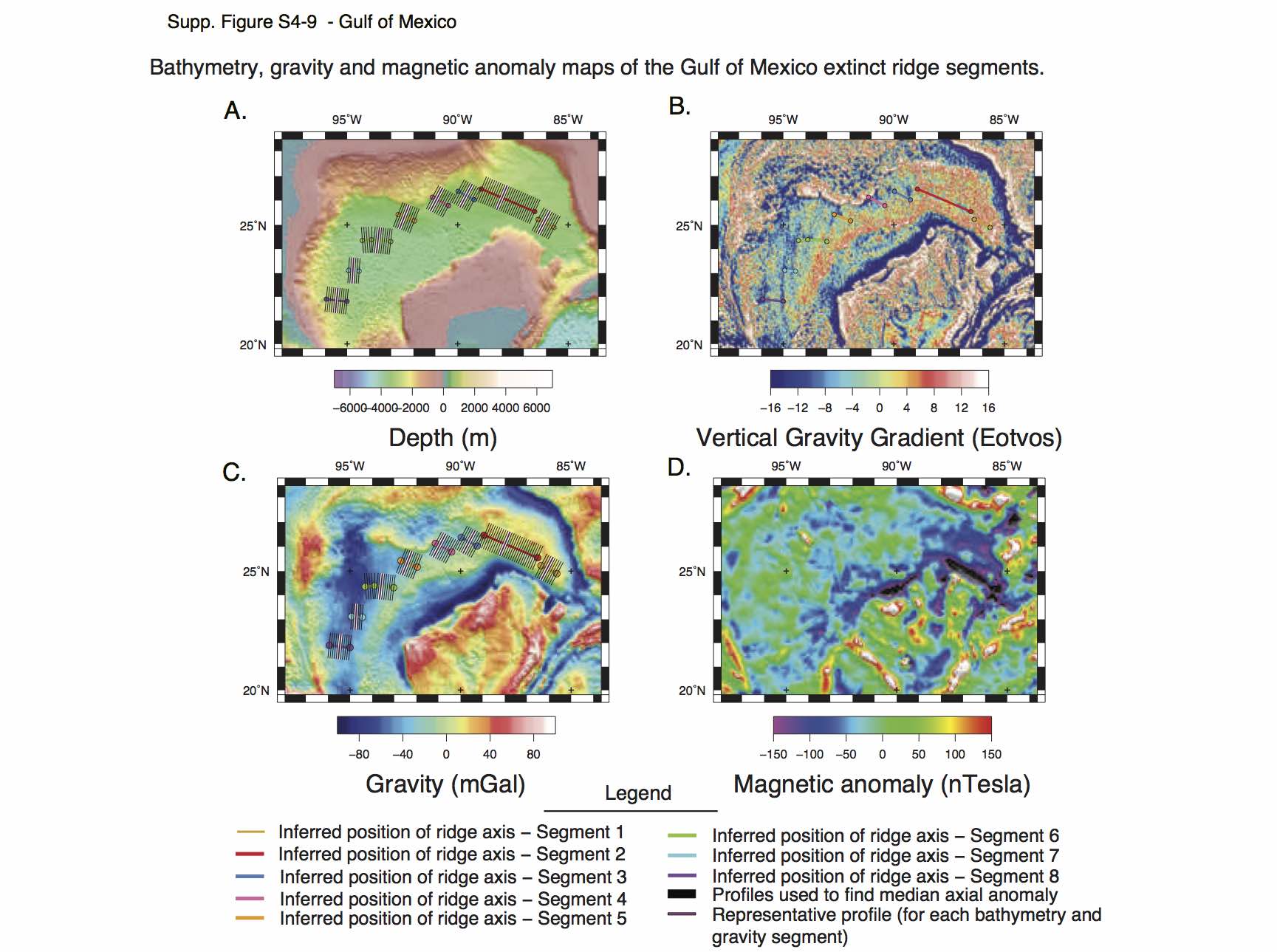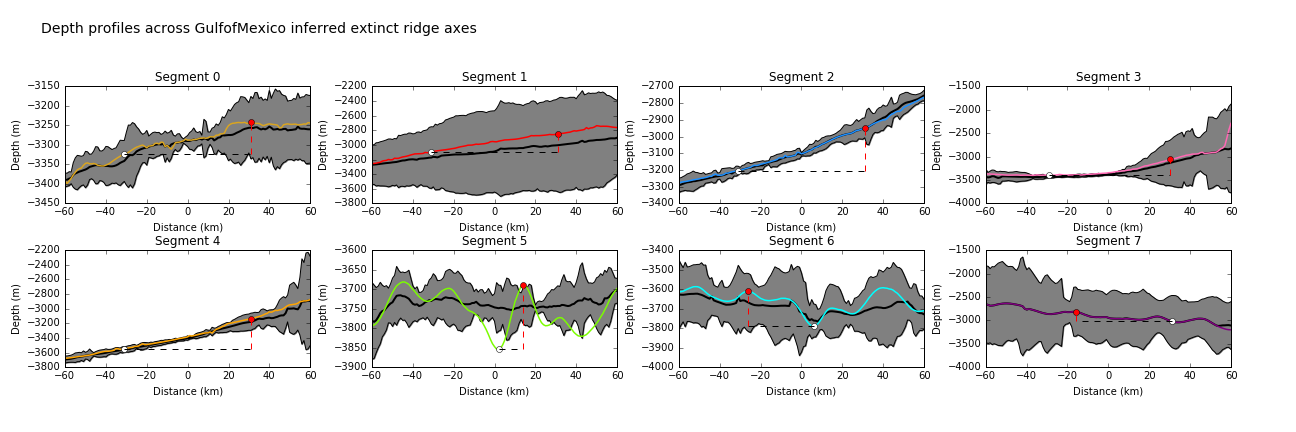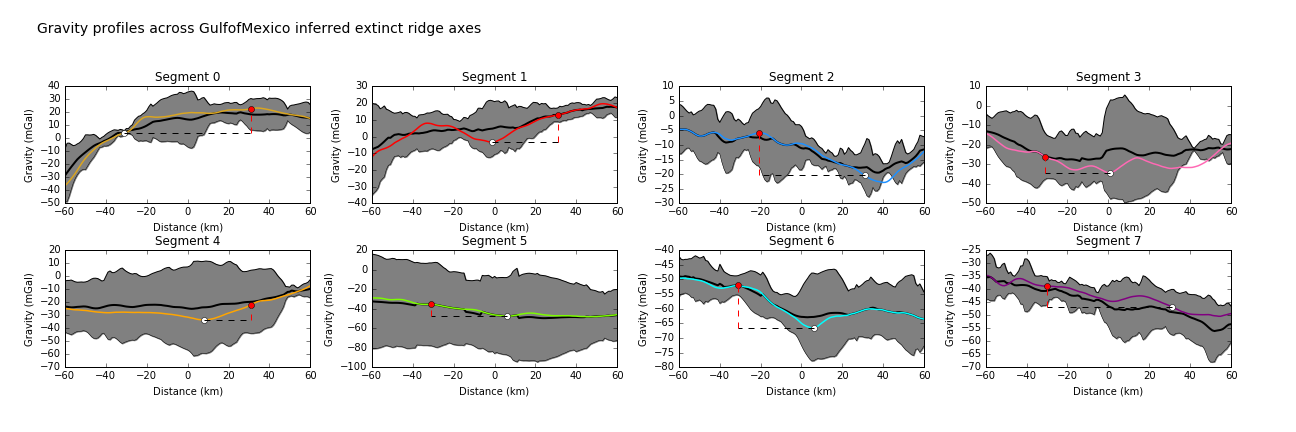| Ocean: | Marginal basin |
| Spreading center type: | Large-scale MOR most likely, however also suggested to have been a backarc basin spreading center (Stern and Dickinson, 2010) |
| Time of cessation: | Ca. 147 Ma, no magnetic anomalies have been identified (Ross and Scotese, 1988) |
The Gulf of Mexico hosts thick sedimentary sequences of up to 15 km (Stern and Dickinson, 2010), that make it difficult to date the oceanic crust in the basin. Although no magnetic anomalies are identified in the Gulf of Mexico, other evidence such as syn-rift sedimentary packages suggests that it formed in the Jurassic (Pindell and Kennan, 2014; Ross and Scotese, 1988; Stern and Dickinson, 2010). Most studies propose that the spreading center in the Gulf of Mexico was likely to have been a mid-ocean ridge that developed after the Yucatan block rifted away from the south of the North American plate (Pindell and Kennan, 2014; Ross and Scotese, 1988). However, Stern and Dickinson (2010) offer a detailed argument that the spreading system may have been a backarc basin.
An early quantitative reconstruction of the region was developed by Ross and Scotese (1988), who incorporated all available data to improve on existing reconstructions. Ross and Scotese (1988) proposed that the Gulf of Mexico is underlain by continental crust, however, more recent reconstructions are less confident of this assumption (Pindell and Kennan, 2009).
Pindell and Kennan (2009) have proposed a widely accepted model for the opening of the Gulf of Mexico that has been incorporated into regional (Boschman et al., 2014) and global reconstructions (Müller et al., 2016). In this model argues the continental Yucatan Block rifts away from the continental North American plate towards the southeast, at a similar time as the opening of the Central Atlantic (Pindell and Kennan, 2009). A counter-clockwise rotation of the Yucatan block is proposed that is supported by the identification of curved fracture zones and the pole of rotation for the Gulf Mexico opening is argued to have been situated just south of the eastern end of the ridge (ibid). The spreading center is proposed to have ceased more recently than suggested in earlier works, at around 135 Ma (Pindell and Kennan, 2009).
Stern and Dickinson (2010), reviewed global examples of active and extinct backarc basins and argued that the Gulf of Mexico could represent a former backarc spreading center. They argued that it could have formed at an oblique angle to the subduction zone situated off the west coast of the Americas and that a magmatic arc was present in Mexico contemporaneous to the opening of the Gulf of Mexico (ibid.). However, their schematic illustration of the location of magmatism relative to the basin location (Figure 3, Stern and Dickinson, 2010), shows a significant lateral offset between this zone and the basin. Due to this problem, we are unconvinced that the Gulf of Mexico developed as a backarc basin.
A regional plate reorganization, perhaps linked to a change of the spreading direction in the Central Atlantic, is suggested as a possible reason for cessation (Ross and Scotese, 1988; Pindell and Kennan, 2009). The reconstruction of Pindell and Kennan (2009), shows that active spreading commences to the south of the Yucatan Block prior to cessation in the Gulf of Mexico and that this creates a continuous spreading boundary by joining the young spreading ridges in the proto-Caribbean seaway and the Colombian seaway. Large-scale transform plate boundaries were active on the east and west boundaries of the Gulf of Mexico during its opening, with the western end linking to a triple junction with ridge-fault-fault configuration (Pindell and Kennan, 2009). It is possible that this triple junction became unstable and that this drove the local plate reorganization.
Alternatively, Stern and Dickinson (2010) argue that the reason that the Gulf of Mexico failed was related to its proposed formation as a backarc spreading center. They argue that its duration of spreading would be expected to be relatively short, given that many backarc spreading centers have a duration less than 30 Myr (Stern and Dickinson, 2010).
The trace of the extinct ridge axis in the Gulf of Mexico can be identified in the updated vertical gravity gradient dataset of Sandwell et al. (2014), as noted by the authors. Due to the relatively weak gravity signal, determining the axial segments from the fracture zones is more challenging and these are inferred from plate reconstructions that give the likely direction of spreading.
Boschman, L. M., van Hinsbergen, D. J. J., Torsvik, T. H., Spakman, W. and Pindell, J. L., 2014, Kinematic reconstruction of the Caribbean region since the Early Jurassic, Earth Science Reviews, v. 138, p. 102-136.
Müller, R. D., Seton, M., Zahirovic, S., Williams, S.E., Matthews, K.J., Wright, N.M., Shephard, G.E., Maloney, K., Barnett-Moore, N., Hosseinpour, M. and Bower, D.J., 2016, Ocean Basin Evolution and Global-Scale Plate Reorganization Events Since Pangea Breakup, Annual Review of Earth and Planetary Sciences, v. 44, no. 1, p. 107-138.
Pindell, J. L. and Kennan, L., 2014, Tectonic evolution of the Gulf of Mexico, Caribbean and northern South America in the mantle reference frame: an update, Geological Society, London, Special Publications, v. 328, p. 1-55, doi: 10.1144/SP328.1.
Ross, M.I. and Scotese, C.R., 1988, A hierarchical tectonic model of the Gulf of Mexico and Caribbean region, Tectonophysics, v. 155, no. 1, p. 139-168.
Stern, R. J. and Dickinson, W. R., 2010, The Gulf of Mexico is a Jurassic backarc basin, Geosphere, v. 6, no. 6, p. 739-754.


